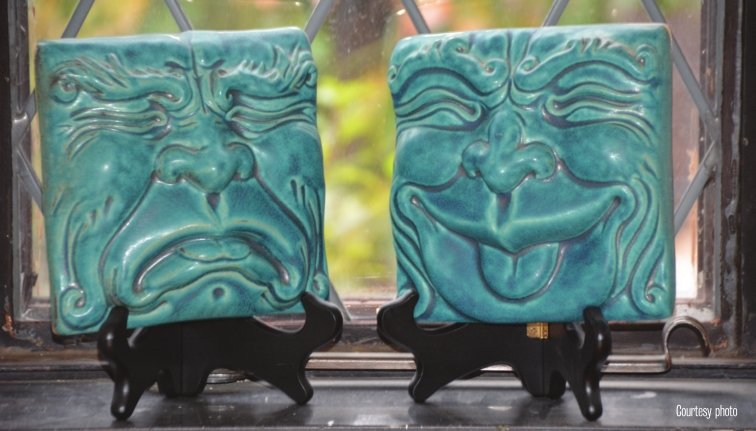
In the 1960s “white flight” saw Detroiters abandoning their homes for the suburbs leaving behind architectural one-of-a-kind installations of Pewabic Pottery. Looters soon moved in, taking with them anything that could be carried. Fireplace surrounds, fountains, floors and the decorative trim of Pewabic Pottery began showing up at flea markets.
The famed arts and craft tile which has its roots in early 1900s Detroit was hot again and in more ways than one. The founder of Pewabic Pottery, Mary Chase Perry Stratton, got her start creating tiles for her own home and ultimately formed a company with her next-door neighbor Horace Caulkins to meet the demand from architects. Originally, the production facility was located in a carriage house until 1907 when it was moved into a new location on E. Jefferson Avenue in Detroit where Pewabic Pottery resides today.
Locally, numerous installations of the tile were made on the MSU Campus including at the Alumni Memorial Chapel, MSU Union and Kedzie Hall. Stratton’s iridescent glazes were perfectly suited for the popular Collegiate Gothic style. Kedzie Hall, completed in 1926, has some of the most elaborate uses of Pewabic Pottery tiles including on the shield motifs in the interior. On the exterior, the iridescent tiles glisten when the sun reflects off of them.
However, the glow faded for Pewabic Pottery as tastes changed. When Stratton died in 1966, the company and its assets were donated to MSU. For more than a dozen years, MSU would shepherd Pewabic Pottery, and in 1979, the university would turn the company over to a non-profit society just in time for the renewed interest in arts and craft styles.
Pewabic Pottery also began creating specialized tiles as awards given by organizations. Locally, Preservation Lansing uses a specially-created tile to recognize local preservation projects. During the 1980s, Governor Blanchard used a 4x4 inch tile as gifts showing the outline of the state.
These tiles are now highly sought by collectors.
Pewabic continues to use century-old molds to create some of its items, but also is aggressively creating new items for the decorative market. Their annual holiday market is very popular.
From her childhood days in Hancock, Michigan, Stratton began making figurines from the area’s well-known red clay. After moving to Detroit, she would become a popular painter of china.
In her book, “Pewabic Pottery,” author Cara Catallo, retells the history of Pewabic Pottery and its creative muse Stratton.
Stratton began experimenting with formulas for clay pottery and then moved on to experimenting with glazes and the various formulas to create certain colors and effects. For a long time, it was a common urban rumor that when Stratton died in 1966, she took her formulae to the grave with her. Thankfully for today’s potters, it was not true. Modern Pewabic pottery looks much like it did in the 1920s.
Very early in the company’s history, Stratton was adopted by famed Detroit patron and collector, Charles Freer, who helped her enhance her artistic sensibilities. She gravitated to simpler forms and attractive glazes inspired by the earth’s minerals and nature.
Despite growing success, her pottery still didn’t have a name or a permanent home. In 1904, Stratton chose “Pewabic” a name she had heard growing up in the Upper Peninsula. As a child, she and her father would walk on the grounds of the Pewabic Copper Mine. Pewabic is thought to be derived from the Ojibwa word, “bewabic” which means iron or metal.
One of the first commercial successes for Pewabic Pottery was the bar in Detroit’s Griswold Hotel. The owner hired the company to create a bar with her tiles. When they were fired, they came out less than perfect, spotted with many imperfections, but the owner loved them.
Business boomed, and following the 1903 St. Louis exhibition where Pewabic Pottery was exhibited, plans were made for a larger headquarters. When it was finished in 1907, the Tudor-influenced structure fit perfectly in its location on East Jefferson, and many of the tiles created by Pewabic Pottery ended up in the mansions being built adjacent to its location.
Catallo’s well-researched book also looks at the many artistic installations Stratton had in the Detroit area. This includes those at the Detroit Public Library, the Cranbrook Institute of Science and also at numerous churches across the country, including the Basilica of the National Shrine of the Immaculate Conception in Washington D.C.
The book also details the decline of Pewabic Pottery following the depression era and Michigan State University’s role as a saving angel.
One of the author’s conclusions is there is nothing more Detroit than Pewabic Pottery.
Support City Pulse - Donate Today!
Comments
No comments on this item Please log in to comment by clicking here